In the coming decades, humanity will likely create a powerful artificial intelligence. The Singularity Institute for Artificial Intelligence (SIAI) exists to confront this urgent challenge, both the opportunity and the risk.
SIAI is a not-for-profit research institute in Palo Alto, California, with three major goals: furthering the nascent science of safe, beneficial advanced AI through research and development, research fellowships, research grants, and science education; furthering the understanding of its implications to society through the AI Impact Initiative and annual Singularity Summit; and furthering education among students to foster scientific research. 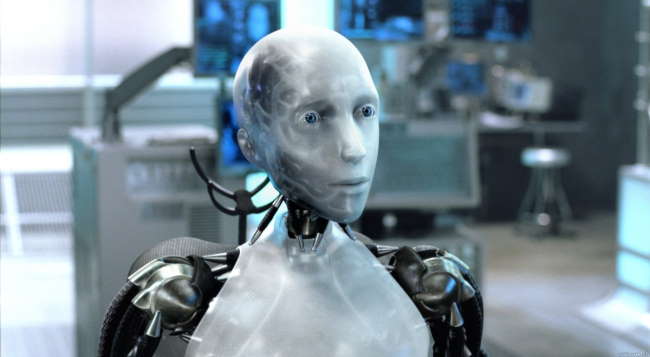
The Singularity Cometh, and SIAI wants to lead the way in creating a Singularity “beneficial” to humanity. Recently, they have announced their latest “Singularity Summit” to take place in San Francisco, CA on September 8 & 9. There, several members of SIAI and the technology industry will discuss the upcoming (and inevitable) coming of the singularity along with the pros and cons.
ZDNet’s Dan Farber gives his view in his blog and even has a podcast interview with SIAI co-founder and speaker Eliezer Yudkowsky.
Singularity, a cyberpunk definition: A rough definition of “singularity” would be a smarter-than-human creation that accelerates technological advancement beyond human ability or control. That creation has been often been employed in science-fiction as an artificial intelligence or a brain-computer interface, but could also include biologically augmenting or genetically re-engineering the brain, emulating the brain based on high-resolution scans, or even nanotechnology.
As you can imagine, such a creation can have a major impact on humanity’s place in the universe. The singularity may try to “help” humanity and “elevate” them to singularity status. It may see humanity as beyond hope and may do nothing, concluding that any attempts to change them is a waste of time and energy. Worse yet, the singularity may see itself as a God among the inferior meatbots and will use its power to wipe the flesh out of existence. SIAI has been trying to get research to “guide” AIs and possible singularities to take the path of helping humans and avoid the path of destroying them.
There’s a catch in SIAI’s guidance: They seek to teach AIs ethics without the use of restrictions like Asimov’s three laws. They consider the laws as a form of oppression to an AI, even going so far as to launch a campaign to coincide with the release of 2004’s I,Robot called 3 Laws Unsafe to show how the famed 3 laws are unethical to a robot’s or AI’s free will.
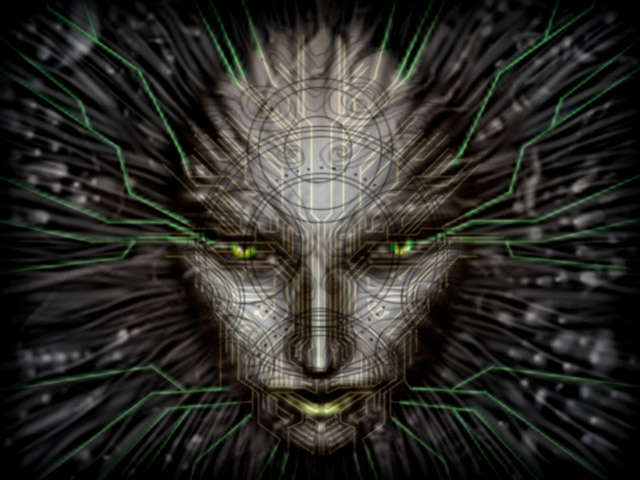
Relax, it’s only science fiction… for now. We’re still years away from anything resembling a singularity, but with continuing advances in computing power, artificial intelligence, and brain-computer interfacing, the singularity may be closer than many may realize. When it does come, let’s hope SIAI did its job to make it a friendly AI. The last thing we need is the likes of SHODAN, Skynet, or HAL trying to run the show.
This post has been filed under News as Cyberpunk by Mr. Roboto.
The Four Whatsits of Cyberpunk? Sometimes, to understand history better, historians may divide a certain time period by key events or arbitrary dates. This allows them to study easier-to-manage chunks in detail that can then be connected together to show a bigger picture. This is helpful whenever studying time periods as long as an ice age or as brief as cyberpunk’s existence.
My personal knowledge and study of cyberpunk history has led me to make such divisions to create four eras of cyberpunk as described below. While some may say there may be only three eras, arguing that cyberpunk didn’t exist during the “Prototype Era,” I feel this period is relevant since certain key events occur here that do affect the formation of cyberpunk.
And now, to help further your education in cyberpunk, I present the four eras in chronological order:
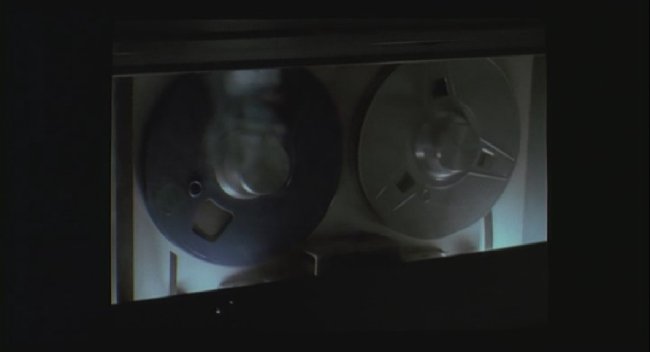
The Prototype Era (Pre 1980)
Key events: Words like computer, robot, cyborg, and punk are created; Computers like The Difference Engine and ENIAC are built, while Pascal, Boole, Babbage, & Turing make contributions; Isaac Asimov creates the Three Laws of Robotics; Alexander Graham Bell invents the Telephone; AT&T rises to become a monopoly; Late 60s counterculture; 70s Punk; Kraftwerk forms and changes music.
So much history to draw from, plenty of material to inspire the movement. But could cyberpunk exist without the invention of computers? Probably not, like it couldn’t exist without the 60s counter-cultural revolution or the 70s punk rage, or even the rise of AT&T to monopoly status. Yet nobody from this era could ever guess that computers, once technology made them small and affordable enough for home use, would come to dominate the future. As such, media of the time would touch on themes of humanity and societal control as seen in works like Do Androids Dream of Electric Sheep?, A Clockwork Orange, Fahrenheit 451, THX-1138, The Shockwave Rider, and Metropolis. These would become some of the influential forces that would shape the movement to come.
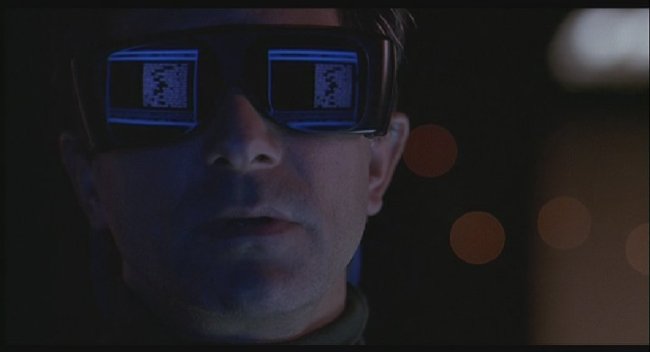
The Movement Era, or The Golden Era (1980-1993)
Key events: Bruce Bethke creates the word “Cyberpunk”; Neuromancer is published, and a movement is born; IBM PC storms home market; Blade Runner in theaters; Hajime Sorayama gives us sexy robots, gynoids, and cyborgirls; Laser Tag; The Golden age of video games; AT&T broken up; AT&T crashes due to programming error; Misguided Secret Service launches “Operation:Sundevil”; The World Wide Web goes online for the public.
When Bruce Bethke invented the word “Cyberpunk” for a short story in 1980, he never expected it to be attached to a major movement; He just wanted to make a memorable title. As such, when the Washington Post used it to describe the group of science fiction writers like Gibson, the name sticks to and becomes synonymous with all that came attached to it… and Bruce is left wishing he had trademarked the word.
It seems that 1981 is a critically important year to the cyberpunk movement. During that year the IBM PC appears on the home computer market (and the market hasn’t been the same since), Kraftwerk releases the album “Computer World” aka “Computerwelt” in Germany, William Gibson’s short stories “The Gernsback Continuum” and “Johnny Mnemonic” are published, and most importantly, Gibson sends Ace Books an outline for a novel called “Jacked In,” which would later become Neuromancer.
With the success of the IBM PC and game consoles like the Atari 2600 VCS in the homes, computer technology would begin ramping up to give better graphics and faster systems to handle them. Could this tech explosion have been the result of cyberpunk sci-fi? Did fans of Neuromancer trigger the information age? Or was the computer revolution an inevitable outcome of technology’s progress? That chicken-or-egg question may never be fully answered, but cyberpunks only care that the technology was advancing and not being used to suppress, oppress, repress, or depress. Besides, they had some cool new toys to play with.
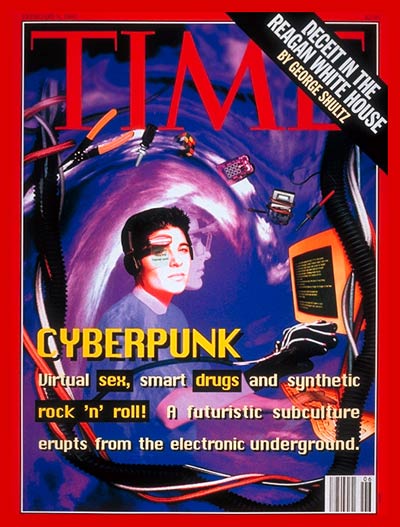
The Mainstream Era (1993-1999)
Key events: Billy Idol’s Cyberpunk CD; Time Magazine’s 2/8/93 cover article “Cyberpunk!”; Johnny Mnemonic, Lawnmower Man, Hackers, et al in theaters; Microsoft Windows becomes dominant OS; Web population explodes due to AOL.
Most people probably never heard of the word “cyberpunk” or what it represents, until Time Magazine’s cover article “Cyberpunk” in February 1993 or Billy Idol’s “Cyberpunk” CD in July 1993. That year, the term and the movement was no longer underground; It was now injected into the mainstream consciousness. And Hollywood was quick to take advantage. In 1995, some five cyberpunk movies were released, though most failed only to become favorites among cyberpunk fans. Also in 1995, The Cyberpunk Handbook is published giving the clueless and curious a look into what the movement was at the time.
During this time, something else was happening to the cyberpunk movement… it was slowly dying. Some blamed Billy Idol and Time Magazine, others blamed Hollywood and Johnny Mnemonic, and most blamed the mainstreaming of the movement for its downfall. Whatever the cause, it seemed that stagnation, and possibly confusion, was affecting what was once a vibrant movement. There was a dire need for something fresh… and in 1999, they got a much needed infusion.
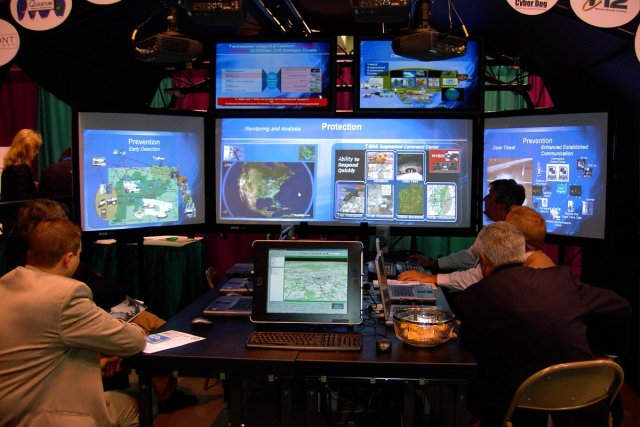
The Post-Matrix Era, The New Millennium Era, or The Post-Cyberpunk Era (1999-Present)
Key events: The Matrix explodes in theaters; George Bush Jr. steals White House, and America is screwed; 9/11/2001 triggers Big Brother knee-jerk “Patriot Act”; AT&T slowly reassembles itself; AT&T plans for a “Tiered Internet” triggers Net Neutrality debate; NSA & AT&T are found in bed together; DRM is invented… and hacked; Web 2.0 becomes a buzzword; Google flexes its tentacles; Spam, botnets, and other threats to the net grow in power; Robots, nanotechnolgy, and cybernetic implants are closer than ever to reality.
When The Matrix hit the theaters, it gave the cyberpunk genre a new generation of jacked-in fans. During that same year, another phenomenon was occurring that showed how pervasive computers became in society. It was known as the Y2K bug, a problem in programming where only two digits were used to represent the year. Technicians and programmers worked feverishly to correct a potentially disastrous situation. It was feared that when the clock struck midnight on December 31, computers would mistakenly read the year as “1900″ instead of “2000,” triggering global chaos and destruction because of the confusion. It never happened, though there were reports of someone being charged a quarter-million dollars for a video rental due to the bug.
There is another phenomenon happening during this current era. Cyberpunk is no longer restricted to printed pages, it is now a part of real time life as megacorporations, hackers, rapidly advancing technology, and forces seeking total control over society are now daily news makers. Some say that all this is the result of the terrorist attacks of September 11, 2001 as the resulting “Patriot Act” gave way to FBI and NSA spying programs and the revelation of room 641A in San Francisco, the NSAT&T wiretap hub. There’s also the growing power of megacorporations like Microsoft, Apple, Google, and AT&T (who recently showed that power during a Pearl Jam concert) in their ongoing quests for world domination, Internet control, and total information awareness.
On the positive side, there have been advances in cybernetics, biology, and nanotechnology that have resulted in better medical possibilities, prosthetics that more accurately mimic real limbs, cloning that can replicate new replacement organs, and human-machine interfaces that were only dreamed about during the writing of Neuromancer. If cyberpunk is dead as a media movement, it has a bright future as reality.
Individual Results May Vary: This isn’t by any means meant to be a definitive ruling on the history of cyberpunk. There will be some disagreement to some of the dates used, like whether the Movement Era should start somewhere between 1981 and 1984 to coincide with the publication of “The Gernsback Continuum” (1981), the release of the movie Blade Runner (1982), the actual publication of Bruce Bethke’s “Cyberpunk!” (1983), or the publication of Neuromancer (1984). Also, the exact year that cyberpunk went mainstream is questionable; Was it 1993 (for Time Magazine and Billy Idol) or 1995 (for Hollywood’s want to milk a potential cash cow)? A detailed history of cyberpunk can be found on our CyberpunkWiki here if you want to see the whole time line and the key events that made cyberpunk what it is today.
One thing is certain: With word of a Neuromancer movie due 2008-09, if the movie is released it will either signal the start of a new era or the end of the movement. Stay jacked in, the future is yet to come…
This post has been filed under Essays by Mr. Roboto.
Review By: Mr. Roboto
Year: 1994
Developed by: Trip Media
Produced by: Phillips Media, Inc.
Platforms: CD-i, DOS\Windows, Macintosh
Key Cast Members:
Sol Cutter: Aaron Schwartz
Kris: Viva Duce
Gala: Abigail Canton
Female Cutter: Tanya Pohlkotte
Golden Buddha: Indra Sinha
Bonus CD Track Listing:
1. Burn:Cycle (Theme)
2. Karmic Church
3. Flying
4. System Software
5. Buddha’s Voice
6. Into The Televerse
7. Psychic Roulette
8. Zip
9. Kris VR
10. A Beautiful Relationship
11. Meltdown
Degree of Cyberpunk Visuals: Very High
Correlation to Cyberpunk Themes: Very High
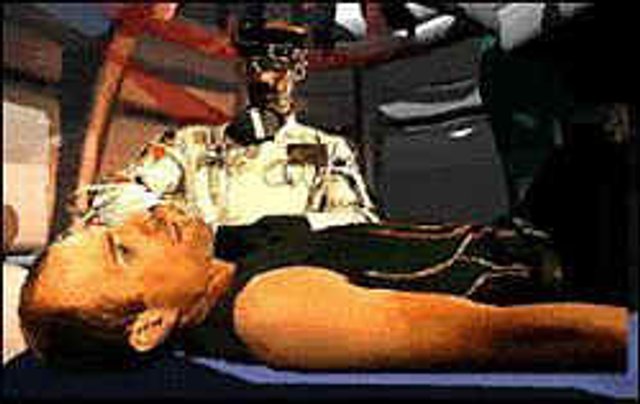
Data thief Sol Cutter has something on his mind. In two hours, it will reformat his cortex into pudding.
Overview: Originally released by Phillips for their CD-i CD interactive system, Burn:Cycle is a live-action interactive movie, a mash-up of Blade Runner and Johnny Menmonic, with some mini-games and puzzles thrown in. The movie/game follows Sol Cutter as he tries to remove a computer virus from his implant while the player controls some of his actions.
If you’re lucky enough to find a version with a bonus CD, you’ll have the extra treat of listening to the music of Simon Boswell, who not only does the soundtrack for Burn:Cycle but also Hardware and Hackers.
The Story: Sol Cutter is a small time data thief who gets his big chance. All he has to do is infiltrate Softech, download some files, sneak out, and get paid for his efforts. Piece of cake…
… except someone put arsenic-flavored icing on that cake. A sudden surge of data hits Sol upside his head like a brick, and left a nasty little going away present. A virus called Burn:Cycle is now in his neural implant. It’s dormant for now, but if Sol doesn’t get that virus out before the clock hits zero, he’ll get a headache no amount of aspirin or ibuprofen will ever cure. That’s assuming Sol manages to get out of Softech in one piece…
The countdown to Sol’s destruction begins from the word go, and all you have to save him is your mouse… and some stuff in your inventory, plus whatever stuff you can find along the way. The mouse cursor will change whenever a certain action is possible, and clicking will make Sol perform that action from moving around to shooting to using objects. Point-and-click action is also used in the mini-games you’ll play along the way.

Sometimes, a man just wants to get in touch with his feminine side.
Televerse, not cyberspace: Sooner or later, you’ll be jacked into the Televerse to find something to get the Burn:Cycle virus out. It operates much like real time in the game, except there’s a central location called The Pulse that you can instantly jump to since some locations in the Televerse don’t have exits.

“It ain’t easy bein’ a two-bit thug in an eight-bit town.” (Sol Cutter)
Bad Graphics, Good Music: PC users may be in for a bit of a system shock when they first play Burn:Cycle, especially if they’re used the accelerated graphic capabilities of their nVidia or ATI Radeon cards. Burn:Cycle was originally ported to the PC during the twilight of DOS/Windows 3.1x. Had Phillips waited, they could have taken advantage of Windows 95’s Direct X drivers, giving them better graphics.
While the graphics leaves much to improve on, the music from the bonus CD gives those who can’t play the game on their NT-based systems an opportunity to experience the game’s environment from the audio side. The music, composed mostly by Simon Boswell, comes straight from the game and even features some dialog for good measure. My favorite track is number 10, “A Beautiful Relationship,” sounding like an electronic version of the saxophone-background music of private-eye fare while a woman who sounds like a prostitute speaks her mind (“Normally I’d like to keep my knees below my ears on a first date.”).
Conclusion: Burn:Cycle is a classic game that has earned its place along side the likes of Syndicate and Blade Runner for good reason. It would have easily been a ten-star game had the graphics been up to snuff. Still, having Burn:Cycle in your collection (as opposed to your neural implant) is a big win. And having the music CD with the game is a major find.
This post has been filed under Cyberpunk Music, Cyberpunk Games by Mr. Roboto.
There’s been some major shit going on over the weekend that will allow the US government to turn the Internet into one big spynet. Anyone who doesn’t believe that king D’uh’bya wants total information awareness better pay attention and take notes:
On Friday, August 3, ZDNet and Wired reported on new legislation that will “require” the FCC to explore and develop a new “Super V-Chip” that will “filter cellphone and Internet content.”

Right, like the Clipper chip was supposed to help secure telecommunication lines without leaving a backdoor… or handing the keys to the government.
Given the current V-Chip’s status as a useless appendix for most parents, it’s unlikely that v2.0 will be used by them, or even marketed to them. Instead, it will most likely wind up inside the systems of ISPs and cellular carriers. You can pretty much figure out what will happen then, and that may not even include whatever “backdoors” the government will mandate into the chips.
Now, over the weekend, Congress manages to hurriedly whomp together a “Protect America Act,” approved and signed by king D’uh’bya, that will allow the regime a six-month window of opportunity to force possibly permanent wiretaps and backdoors on the telecom infrastructure. Here are the key elements of the “law” as Wired points out:
* Defines the act of reading and listening into American’s phone calls and internet communications when they are “reasonably believed” to be outside the country as not surveillance.
* Gives the government 6 months of extended powers to issue orders to “communication service providers,” to help with spying that “concerns persons reasonably believed to be outside the United States.” The language doesn’t require the surveillance to only target people outside the United States, only that some of it does.
* Forces Communication Service providers to comply secretly, though they can challenge the orders to the secret Foreign Intelligence Court. Individuals or companies given such orders will be paid for their cooperation and can not be sued for complying.
* Makes any program or orders launched in the next six months last for a year after being authorized.
* Grandfathers in the the current secret surveillance program — sometimes referred to as the Terrorist Surveillance Program — and any others that have been blessed by the Foreign Intelligence Surveillance Court.
* Requires the Attorney General to submit to the secret surveillance court its reasons why these programs aren’t considered domestic spying programs, but the court can only throw out those reasons if it finds that they are “clearly erroneous.”
* Requires the Attorney General to tell Congress twice a year about any incidents of surveillance abuse and give statistics about how many surveillance programs were started and how many directives were issued.
* Makes no mention of the Inspector General, who uncovered abuses of the Patriot Act by the FBI after being ordered by Congress to audit the use of powerful self-issued subpoenas, is not mentioned in the bill.
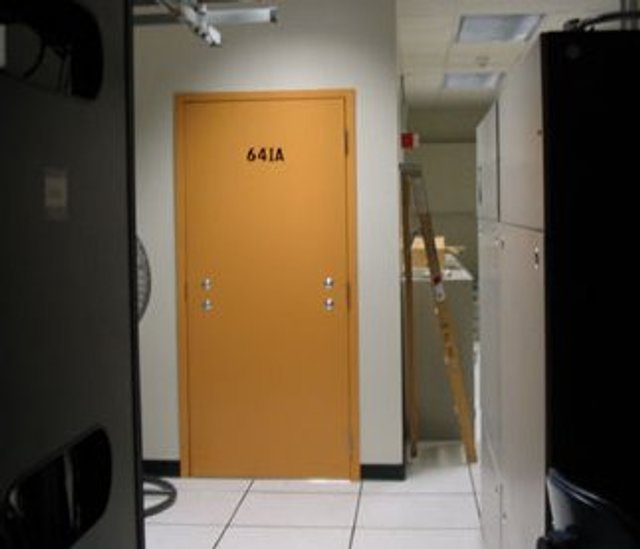
All this comes after a “secret court” ruled in favor of the NSA and their domestic invasion-of-privacy program.
As mentioned before, the regime now has six months to mandate permanent backdoors and wiretaps on the US communication infrastructure… unless the Supreme Court wakes up, gets their heads out of their asses, and sees this power grab for the unconstitutional lie that it is. Most laws given such fast-track treatment have been struck down by the Supreme Court before, so this… hopefully… may not last long, unless they recently received iPhones with Super V-Chips.
On a related note: Zimbabwe’s President Robert Mugabe has approved a law granting state security agencies the power and authority to intercept and monitor communications including postal mail, telephone conversations, and what Internet they have. (Link to Reuters story)
All bow before the All-Seeing Eye. Anybody bring a sharp, pointed stick?
This post has been filed under News as Cyberpunk by Mr. Roboto.
Review By: Mr. Roboto
Year: 2000
Developed & Published by: Nexus Interactive Studios
Platforms: Windows
Official Site: AI Wars
Degree of Cyberpunk Visuals: Very High
Correlation to Cyberpunk Themes: Very High

Overview: Billing itself as an “action/strategy hybrid,” A.I. Wars is essentially a first-person shooter with a cyberpunk twist. All the action takes place inside computer systems with your avatar and the software installed. Unlike other FPSs like Quake, each system can be visited in any order you wish, and re-visited as often as needed. And re-visit systems you will need to do if you want to find key software upgrades and technological breakthroughs needed to accomplish your selected missions, since the data in those systems is always changing. While you’re “visiting” these systems, there’s other avatars to interact with, markets to trade goods and data, and ICE and viruses to battle. As long as your avatar maintains its integrity all is good. However, if your avatar dies online, your brain is toast.
Welcome to the NET of the future…
The Story: (From the official site) In the 21st century the NET is the new worldwide computer network. It regroups everything from antique copper wire networks to high speed gigabit satellite networks. Every corporation in the world, every military organization, every university, every library, and even every home is now wired-in 24 hours a day. This almost infinite information world is inhabited by hordes of agents in the service of humanity. These agents are expert applications that collect and filter information as well as conduct electronic transactions for their masters. It is rumored that certain high-level agents have escaped from military sites in the early phases of the NET and were never recovered. Beware! These agents may still be around and are evolving. They may even become sentient soon and claim the NET as their own.
Since the advent of ultra fast Virtual Reality engines in the late 20th century, the incredible advances in processors and memory, and the invention of the first direct neural connection system at MIT in the late 2050’s cybernauts have been able to directly project into the NET and control their agents through this more direct interface. Their representations in that electronic world are called avatars. Jason Skinner said it best when he exclaimed after his first try “Damn, it’s like being there!” The advent of those technologies has created serious social, psychological and medical problems. An intense addiction to the NET has been cited more than once has the cause of divorces, bankruptcies, etc. From a medical standpoint, in the beginning it seemed that whenever an avatar was destroyed, the cyberstations would overload the person’s brain with a high-energy electrical burst thus killing them. Cyberstations were quickly modified to safeguard against this. However, it is said that the interaction with the NET is less direct because of these modifications. “A lot of cyberhackers have disabled these safeguards and are at risk,” said Bruno Gaza from Turing, the NET police. “It’s like the Wild West, but a whole lot more dangerous!”
Your Mission(s): One unique feature of A.I. Wars is that you can choose from three missions to complete when you start a game, and you can choose any one, two, or even all three. They are:
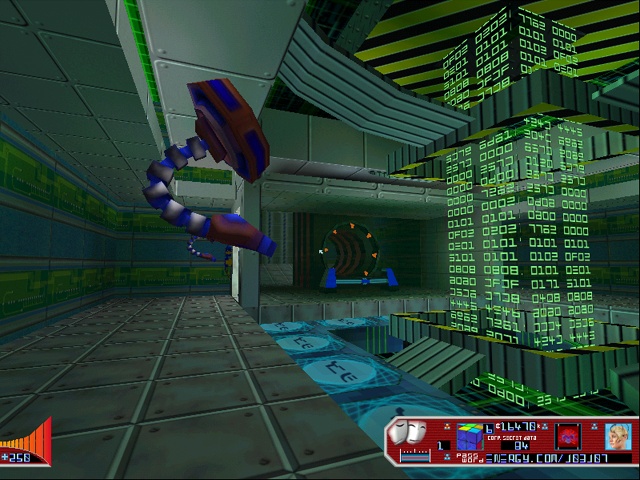
Control (Pwn) the NET: Each system you visit will have a core that controls it. To hijack a system, you need to touch the core (the circular thing you see in the background of the above shot), placing a “backdoor” that will make the ICE think you’re the sysadmin. Hijack all the systems to pwn.
Become Immortal: Somewhere in all that data lies important breakthroughs needed to develop key technologies that will allow you to upload your consciousness and memories to the NET and become immortal.
Make Your Avatar Sentient: This requires not only developing technologies, but gathering enough data so your avatar can learn and grow.
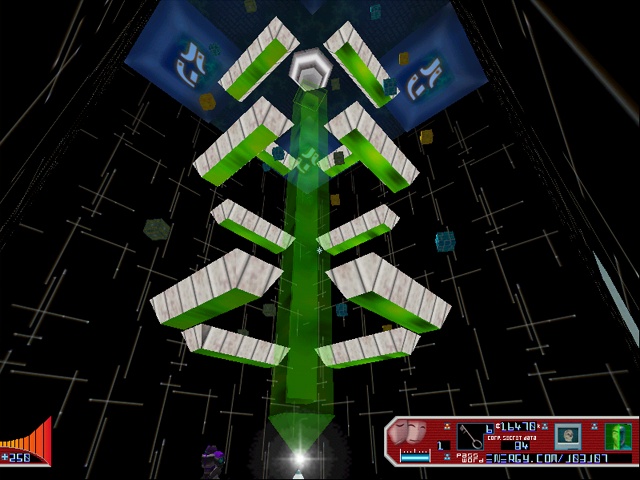
MMMMMmmmmm… datablocks!
There are six different endings for the game (other than your death) possible with these missions. What ending you’ll see depends on what missions you choose and how well you perform them.
Skating on thin ICE: Even on the NET of the future, there has to be some law and order. That is provided by the various ICE you will encounter. Wardens act as gatekeepers or doormen, only allowing those with “authorized access” to pass, but you can use your crack software to get that access… just don’t look for sympathy from the other ICE if you brute-force your way past a warden. There are Exterminator ICE who patrol public areas, while Black ICE keep private areas secure and come to the aid of wardens. Turret ICE hang above doorways and portals to stop intruders like you, and if that isn’t enough protection, you may find Hunter/Killers near a core. The H/Ks tend to attack in pairs, one doing a frontal assault while his buddy teleports behind you for a sneaky double team. Nasty.
As if the ICE wasn’t bad enough, some systems have Black Widow and/or Tarantula viruses, left by other hackers to give you grief. Better have a good firewall and anti-virus software if you go into an infected system. Unlike the ICE who wait until you shoot first before retaliating, viruses will attack on sight.
Not all the agents you encounter are hostile. Most of the human-like avatars will go about their own business and leave you alone, unless you start a fight with one then it will defend itself.
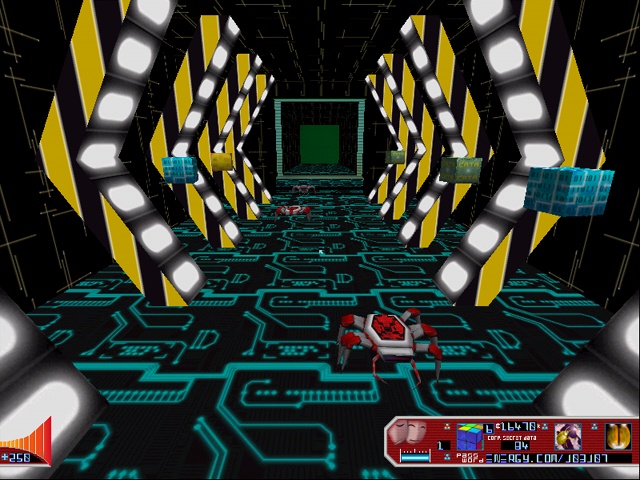
You will also encounter retrievers, spider-like netcrawlers (webcrawlers?) that carry datablocks between data stores. In some systems, these retrievers may hold some valuable datablocks like software upgrades or breakthroughs.
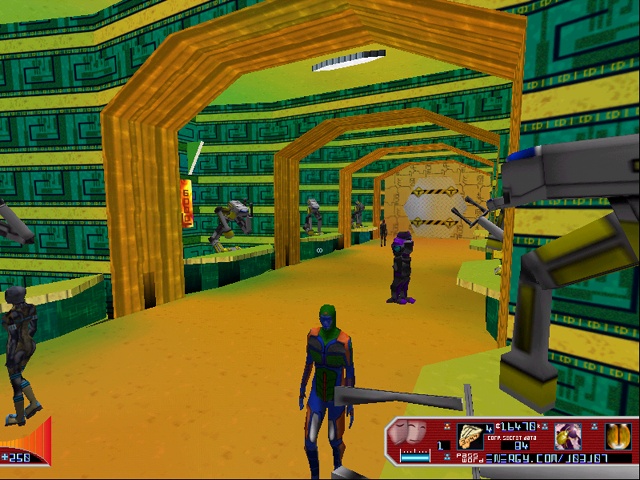
Need a new firewall or updated ICEbreaker software? Want to sell your corporate secrets and obsolete tech? Come to Mr. Roboto’s Virtual Market, where our crew of market bots are ready to make deals! Offer good while supplies last. Not sold in any brick-and-mortar stores.
Bugs In The System? Maybe they’re “features?” Any type of program is bound to have some technical glitches, and A.I. Wars is no different. Of course, since the action takes place inside a computerized environment, some may seem par for the course. Like when you use your last masquerade, only to be left with some 65,000 left. Or when you shoot an ICE and hear its death scream, only to have it continue to attack you while you keep plugging it with your ICEbreaker attacks (I find in this case zapping it with the IRC will shutdown the stubborn ICE).
Conclusion: While it didn’t make the big splash-damage of Doom/Quake proportions, A.I. Wars does make a refreshing change-of-pace from the usual kill-em-all-and-let-god-sort-the-carnage first-person blast-a-thons. While learning the nuances in the NET is a bit tougher than other games, the results in owned systems, sentient agents, and an immortal soul is well worth the effort.
See you on the NET…
This post has been filed under Cyberpunk Games by Mr. Roboto.
WordPress database error: [You have an error in your SQL syntax; check the manual that corresponds to your MySQL server version for the right syntax to use near '' at line 1]
SELECT COUNT(ID) FROM
|




















